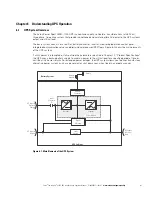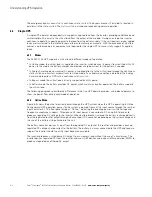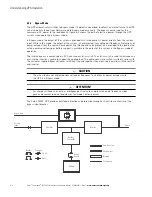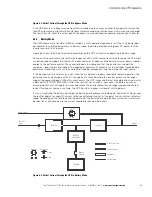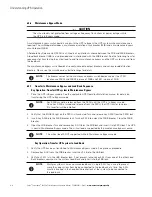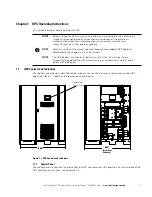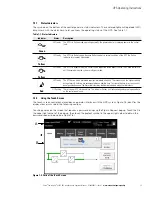
Understanding UPS Operation
6-2
Eaton
®
Power Xpert
®
9395C UPS Installation and Operation Manual P-164000821—Rev 01
www.eaton.com/powerquality
The emergency bypass consists of a continuous static switch. The bypass breaker (if installed) is located in
parallel with the static switch. The static switch is armed and ready during normal operation.
6.2
Single UPS
A single UPS operates independently to support an applied load from the inverter, providing conditioned and
uninterruptible AC power to the critical load from the output of the module. During an outage, the inverter
continues to operate, supporting power to the load from the battery supply. If the unit requires service, applied
loads are transferred to the internal bypass either automatically or manually. With the exception of a battery
cabinet, no other cabinets or equipment are required for the single UPS to successfully support its applied
loads.
6.2.1
Modes
The 9395C-1100 UPS supports a critical load in different modes of operation:
l
In Online mode, the critical load is supplied by the inverter, which derives its power from rectified utility AC
power. In this mode, the battery charger also provides charging current for the battery, if needed.
l
In Energy Saver mode, commercial AC power is supplied directly to the critical load through the continuous
static switch and transfers automatically to Online mode if an abnormal condition is detected. The Energy
Saver mode requires a UPS with a continuous static switch.
l
In Bypass mode, the critical load is directly supported by utility power.
l
In Battery mode, the battery provides DC power, which maintains inverter operation. The battery supports
the critical load.
The following paragraphs describe the differences in the five UPS operating modes, using block diagrams to
show the power flow during each mode of operation.
6.2.2
Online Mode
Figure 6-2 shows the path of electrical power through the UPS system when the UPS is operating in Online
During normal UPS operation, power for the system is derived from a utility input source through the rectifier
input contactor K1. The front panel displays “Online,” indicating the incoming power is within voltage and
frequency acceptance windows. Three-phase AC input power is converted to DC using IGBT devices to
produce a regulated DC voltage to the inverter. When battery breaker is closed the battery is charged directly
from the regulated rectifier output through a buck or boost DC converter, depending on the system voltage and
the size of the battery string attached to the unit.
The battery converter derives its input from the regulated DC output of the rectifier and provides a bucked
regulated DC voltage charge current to the battery. The battery is always connected to the UPS and ready to
support the inverter should the utility input become unavailable.
The inverter produces a three-phase AC output to a customer's load without the use of a transformer. The
inverter derives regulated DC from the rectifier and uses IGBT devices and pulse-width modulation (PWM) to
produce a regulated and filtered AC output.
Содержание 9395C-1000/1000
Страница 2: ......
Страница 23: ...Section I Installation ...
Страница 24: ......
Страница 93: ...Section II Operation ...
Страница 94: ......
Страница 155: ......
Страница 156: ... P 164000821 1 P 164000821 1 ...














